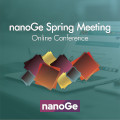Proceedings of International Conference on Hybrid and Organic Photovoltaics (HOPV18)
DOI: https://doi.org/10.29363/nanoge.hopv.2018.162
Publication date: 21st February 2018
Optical design of perovskite solar cells (PSCs) has been demonstrated to be very relevant to push the performance of this emerging technology.[1, 2, 3]
Recently, the research interest has put under the spotlight ABX3 perovskites for their application in multifunction devices that can surpass the Shockley-Queisser (SQ) limit.[4,5] In our talk we will discuss about the possibilities that an optical model opens to improve the efficiency of perovskite-based tandem solar cells. We make use of semi-analytical models based on the transfer matrix to describe light distribution within the device. We will show how design provides a straightforward path towards architectures in which current matching is attained, eventually preventing the field from time-consumable trial and error experiments. Then, we will identify which are the effects that the different components have in the electro-optical performance of the device. Based on this, we will conclude with a roadmap towards the achievement of optically optimised tandem solar cells, where parasitic absorption and reflectance losses are minimized. We merge our optical model with a genetic algorithm to fully optimise a FA0.83Cs0.17PbI1.8Br1.2/MAPb0.15Sn0.85I3 tandem device that outperforms >30% efficiency. This kind of approach promises to be of great importance for the immediate future of this rapidly growing field.
[1] M. Anaya et al., Journal of Physical Chemistry Letters (2015), 6, 48-53.
[2] W. Zhang & M. Anaya et al., Nano Letters (2015), 15, 1698-1702.
[3] J.-P. Correa-Baena & M. Anaya et al. Advanced Materials (2016), 28, 5031–5037.
[4] M. Anaya & J.-P. Correa-Baena et al., Journal of Materials Chemistry A (2016), 4, 11214–11221.
[5] M. Anaya et al., Joule (2017), 4, 769-793.

